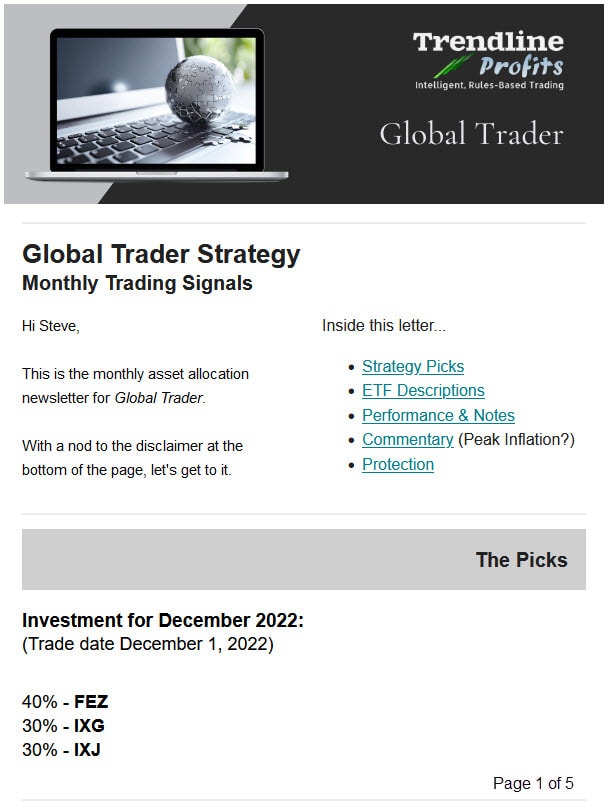Global Trader
|
One could try to pick and choose global assets; an emerging markets fund here, a European fund there. The problem is, even the best of these funds will go through patches that will clobber your portfolio. The emerging markets EEM, for example, lost -16.9% in the 6 years from 2011 to 2016, while the U.S. market was soaring (S&P 500 up 101.2%). All of this makes it tough for buy-and-hold investing.
I think we can do better.
I think we can do better.
A Quick Take
|
The Strategy splits its portfolio into 40/30/30.
Our Global Trader portfolio holds up to three assets each month, typically a single broad-based international or domestic ETF, and one or two global sector funds like healthcare, utilities, energy, and more. During global downturns, equity funds may be swapped out for one or more of the hedges that include U.S. Dollar and currency ETFs - or the "flight-to-safety" U.S. Treasury fund TLT. Broad geographical exposure. Tapping international broad-market and sector funds, with the U.S. equity market as a backstop, Global Trader provides the broadest geographic diversification of the models. An excellent addition. For the investor who wants to add international exposure - but only when outperforming the domestic U.S. market - Global Trader makes an excellent addition. There's more information below, but if you're ready, why wait? You can be placing your trades today.
|
Need more information? OK, let's go in-depth...
Numbers & Charts
|
Over the past 16+ years, from 2008 to 2024 YTD, Global Trader has delivered a nearly 3-fold improvement in Total Return over our benchmark SPY.
Total Return Chart Global Trader vs. SPY, our proxy for the S&P 500
Total Return | 2008 - 2024 YTD (updated monthly) And Global Trader delivered these returns with less volatility and a much lighter max drawdown than our benchmark (see the Compare Strategies page for recent drawdown numbers). Annual Returns Global Trader vs. SPY
Annual Returns | 2008 - 2024 YTD (updated monthly) Now, individual years can vary - sometimes dramatically. And full disclosure: of the last 16 full years (2008 to 2023), the strategy underperformed the benchmark almost half the time: 7 years to be exact. And yet still managed a 3-fold improvement in Total Returns. How can that be? The average winning period has been higher than the average losing period, and those winners add up. In sum, over the long term, Global Trader delivers international diversification without compromising performance. |
Strategy Assets
|
The following broad-market (international and domestic), sector (international), and hedge funds are included in the Global Trader strategy:
Our Broad-Market Candidates Broad Market, International and Domestic
Our Sector (and Hedge) Candidates Global Sectors
Hedge
|
The Mechanics
|
As mentioned above, the strategy splits it's portfolio into 40/30/30 components. Each component operates within its own parameters and with its own set of assets. Here's how that works...
Broad-Market 40% Each month, the strategy conducts a risk-adjusted momentum test on the 6 ETFs from the broad-market equity category. Based on that test, it selects the strongest candidate and buys that ETF to represent 40% the portfolio. Should none meet the performance criteria, the strategy reverts to a safe harbor investment, namely the U.S. Dollar fund USDU or TLT, the popular iShares 20+ Year Treasury Bond ETF. Sectors and Hedges 30/30% The remaining portfolio rotates monthly between a collection of global sector funds, and select currency and metal ETFs. The latter two classes serve as a hedge, and helps reduce maxDD and volatility. Summary So, at any given time, our Global Trader portfolio holds up to three assets each month, typically a broad-based international or domestic ETF, and one or two global sector funds. In down markets, equity funds may be swapped out for one or more of the hedges - or the "flight-to-safety" U.S. Treasury fund TLT.
_____ Note: while the strategy rotates out of higher-risk equity funds and into the relative safety of TLT in the event of a global market downturn, nothing short of perpetually holding cash will protect in the event of a flash crash or a sudden jolt to the market. That said, the pain from most market downturns (i.e. recessions, bursting bubbles, market corrections) can be mitigated by a strategy that switches to relative safety within weeks. |
What You Get
|
|
Ready?
|
The Global Trader international ETF trading strategy is available as a single strategy at $14.95 per month, or as part of the package plans. Cancel at any time; no questions, no hassle. Follow along and see how the strategy catches market moves to the upside, while protecting hard-earned portfolios against major downdrafts.
First 2 months are FREE. |
"I'm really enjoying your 4 strategies. I appreciate the approach and rules-based, non-subjective way that allocations are made for each strategy." --Ed D. |
"We live in interesting times. Your strategies have a great history of performance. I'm using a blended strategy of AM, GT and Bonds. Thanks." --Bob D. |




